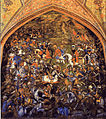Chehel Sotoun
The Persian Garden | |
|---|---|
| Criteria | Cultural: (i)(ii)(iii)(iv)(vi) |
| Reference | 1372-003 |
| Inscription | 2011 (35th Session) |
| Area | 5.8 ha (620,000 sq ft) |
| Buffer zone | 28.92 ha (3,113,000 sq ft) |
| Coordinates | 32°39′27″N 51°40′20″E / 32.65750°N 51.67222°E |
Chehel Sotoun (
The name, meaning "Forty Columns" in Persian, was inspired by the twenty slender wooden columns supporting the entrance pavilion, which, when reflected in the waters of the fountain, is said to appear to be forty.[1]
As with the
The Chehel Sotoun Palace is among the 9 Iranian gardens which are collectively registered as one of Iran's 23 registered World Heritage Sites under the name of the Persian Gardens.[3]
Architecture
In the pavilion, the combined designs of the walls and ceiling of the hall, which are placed in Lachak Toranj (corner and medallion), and the main lines of the building divisions, which are a combination of painting, tiling and other various decorations, make the building one of the best examples of Persian architecture during the Safavid era. At present, the mansion operates as a museum; and its central hall displays some works of art from different periods of Iran.[4]
-
Muqarnas of Chehel Sotoun
-
Shah Tahmasp I
-
Day view of the palace
-
Rear view of the palace
-
Closer view of the palace
-
A sculpture in the garden
-
Golden muqarnas vaulting
-
Inside the museum
-
The Qur'an inkufic script
-
Fresco inside the palace
-
1840, by Pascal Coste
-
Fresco inside the palace
-
Artwork of the Battle of Chaldiran
-
Ceiling of Chehel Sotoun's mirror hall that contains Āina-kāri art
-
Paintings
Notes
- ^ Landor, Arnold Henry Savage (1902). Across Coveted Lands. London: MacMillan and Co., Limited. p. 323.
- ^ Honarfar, Lotfollah (1966). A Treasure of the Historical Monuments of Isfahan; Honarfar L. Isfahan: Saghafi.
- ^ "Otraq.com, Iran's Tourism Guide".
- ^ ww25.irpersiatour.com http://ww25.irpersiatour.com/blog/chehel-sotoun-find-out-about-another-historical-monument-of-isfahan/?subid1=20240426-1041-3645-adb9-b9b310fe0fdc. Retrieved 2024-04-26.
{{cite web}}: Missing or empty|title=(help)
Bibliography
- M. Ferrante: ‘Čihil Sutūn: Etudes, relevés, restauration’, Travaux de restauration de monuments historiques en Iran, ed. G. Zander (Rome, 1968), pp. 293–322
- E. Grube: ‘Wall Paintings in the Seventeenth Century Monuments of Isfahan’, Studies on Isfahan, ed. R. Holod, 2 vols, Iran. Stud., vii (1974), pp. 511–42
- S. Babaie: ‘Shah ‛Abbas II, the Conquest of Qandahar, the Chihil Sutun, and its Wall Paintings’, Muqarnas, xi (1994), pp. 125–42



















